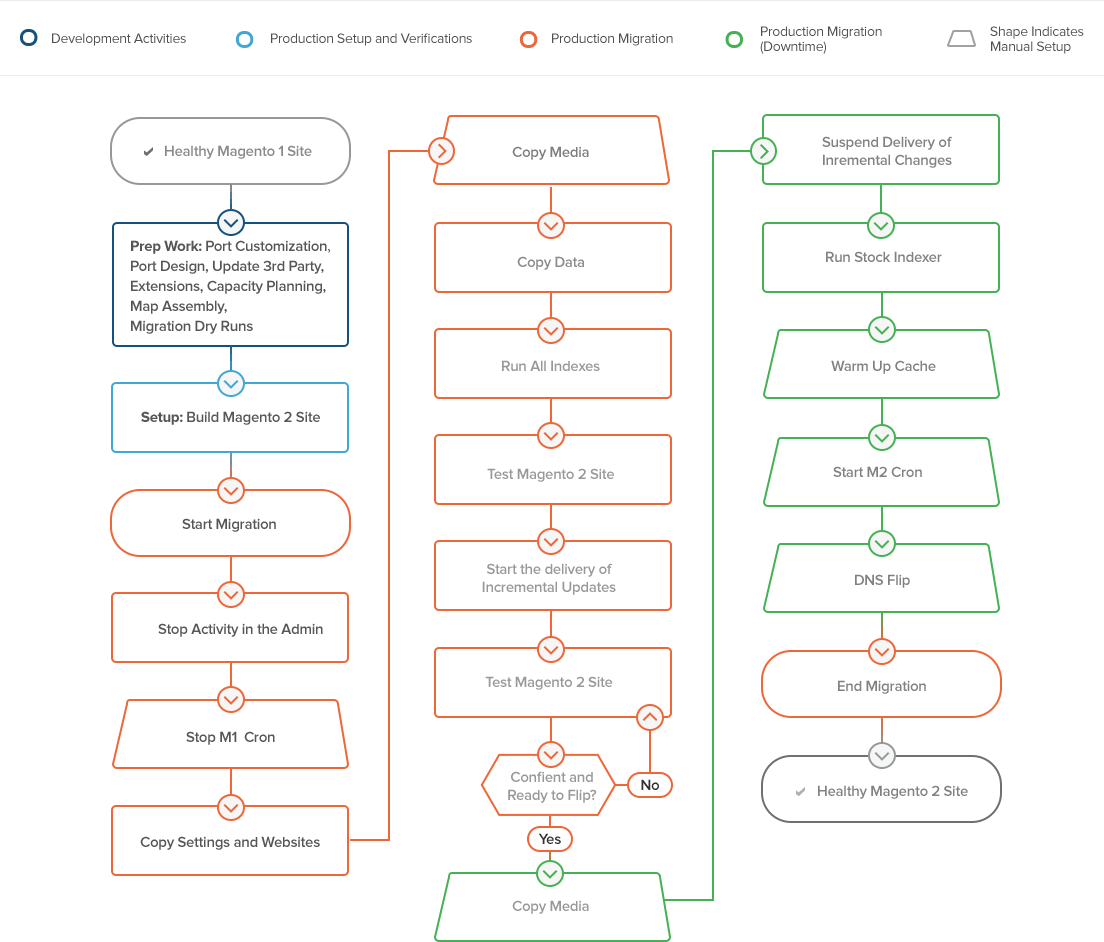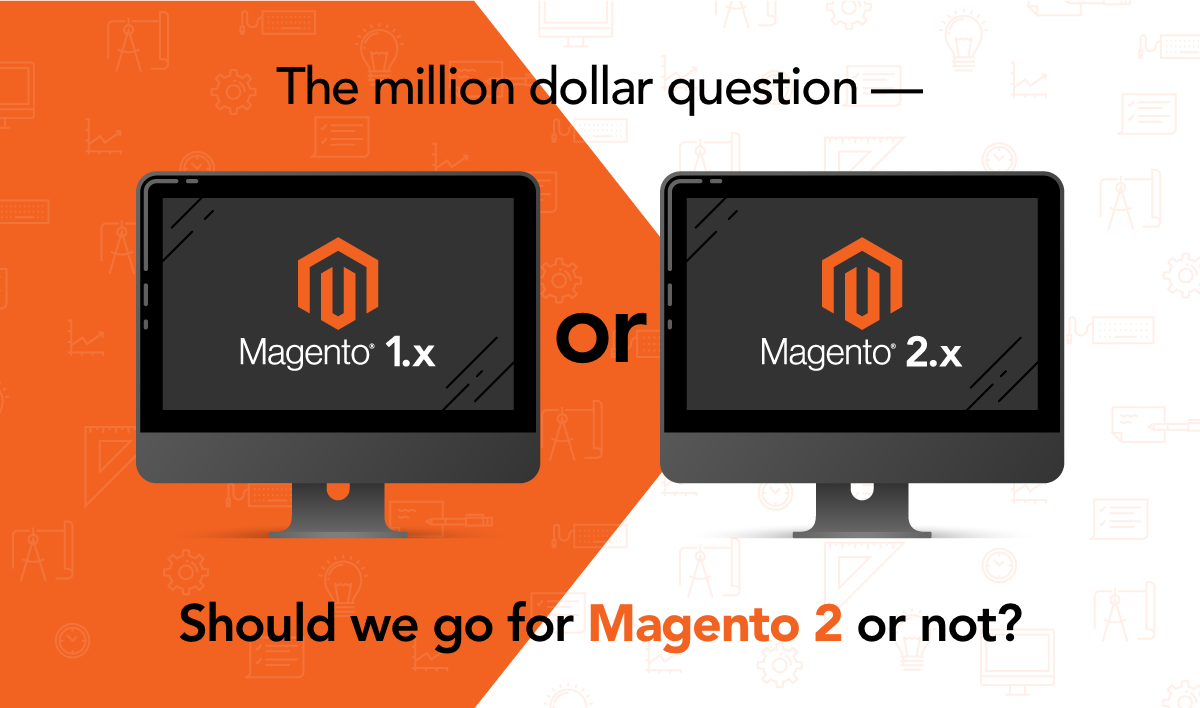Should we go for Magento 1.9 or Magento 2.X is a question we hear from current and potential clients almost on a daily basis. Drawing from our experience in these discussions together with our hands-on experience as specialists in Magento we would like to share our thoughts on this popular topic.
Magento 2: The New Era of commerce innovation
It was in November 2015 that the Magento team announced the “new era of commerce innovation” with the release of Magento 2.0 for the Enterprise and Community editions. The list of the new powerful and innovative features was long, yet today almost one and half years later few merchants are aware what the the upgrade to Magento 2 actually means for their business. Fact is that one of the most common questions we face from our current as well as new clients are related to the migration to Magento 2 in general, and what are the pros and cons in particular.
When searching the web for answers there are some good answers out there, but not always very intuitive for the merchant with limited development background. Magento themselves are saying that Magento 2 provides “enhanced performance and scalability, new features to boost conversion rates, and business agility and productivity improvements”. But what does this actually mean?
In this post, we summarize the pros and cons of the Community Edition of Magento 1 (M1) vs Magento 2 (M2), as well as provide our guidance on what route to take.

The Pros of migrating to Magento 2
So what are the advantages of Magento 2, “the next-generation commerce” as coined by Magento? First let’s start with the features in the frontend, which are experienced by the customer visiting the webstore:
- Speed, Magento 2 comes with full page cache by default. Besides it requires a more updated version of PHP. The result is faster page load times. Some comparisons suggest that with the right settings, page load time in Magento 2 gives up to 50% more speed everywhere but the Add to Cart step. Yet, if PHP7 is not installed some tests show that Magento 2 could even slightly slower
- Smoother check-out process, with fewer steps in the default version. However, the shortcoming of having a streamlined checkout in Magento 1 was, and is, often solved by a 3rd party extension or customization.
Second, there are the advantages seen in back end that only the merchant themselves experience:
- Improved admin experience, with the introduction of an enhanced user interface the admin page is now more intuitive and comes with better functionality. Besides, it comes with a more responsive site for mobile usage.
- More stable extensions, following the introduction of Magento Marketplace about a year ago. The original marketplace for Magento extensions, named Magento Connect, has supported Magento to become the success it is. However, with low barriers of entry for a new extension, the number of extensions has soared and today there are unfortunately quite a few bad ones. To put it simply, Magento Connect is the marketplace for M1-extensions, whereas Magento Marketplace is the place for M2-extensions. A more selective process for the new marketplace has resulted in more stable and better qualitative extensions for merchants using M2.
- Security patch fixes will continue, as allegedly not with M1 after November 2018. Although the developer community most likely will continue to patch security holes, there won’t be any official updates from Magento Inc.
- Roadmap for better planning, there is a roadmap on which features Magento 2 is going to launch in the future.
The Cons of migrating to Magento 2
- Data migration means the effort and costs involved. The risk is high that some issue occurs which results in extra development work.
- Not an upgrade but a new system, ie not just another upgrading of Magento-version but a re-launch from scratch. There are hence the “direct costs” for setting this up, but since the change is actually taking place many merchants also take the opportunity to upgrade design and other features, which in total will increase the scope and consequently the budget further.
- Lack of available extensions, there has been a kind of “chicken and egg”-problem with few merchants on M2 resulting in limited interest to develop extensions. Hence, the number of popular critical extensions is missing, and instead, the merchant has to rely upon more expensive customized solutions. The number of M2 extensions on the Magento Marketplace is however increasing slowly but surely.
- A limited number of skilled developers, as a majority of the merchants are still on Magento 1, many developers still lack adequate experience and knowledge of Magento 2.
- Instability was especially seen in the infancy of Magento 2. According to our own experience as almost all of our M2 customers are on 2.1 now, it is more stable, but still, some unexpected issues may appear during the development. However, compared to the first release, it is about 80% better in terms of stability.
Magento 2: future considerations
After going through the pros and cons for Magento 2, the beginning of the “new era” was indeed a rocky one with many shortcomings. But with the latest version of 2.1, although still some steps behind ideal, the new Magento is getting closer to its full potential.
A relevant concern among our clients is if M1 and the crucial support by the development community will disappear. The answer to that is most likely not, and for sure not in the next couple of years. There are just too many small and medium-sized e-commerce companies out there that for whatever reason will stay on with Magento 1 for a long time. And as long as there is a critical mass of users, there should be a critical mass of developers.
With that said, although security patches most likely will be developed by the community, the number of new useful extensions is expected to decline as the general focus shifts from the old to a new platform. Taking it one step further, relying on community updates can expose your business to unnecessary risk. Consequently, the trend we are already seeing is that the large and profitable merchants are the ones that are in the process to change to M2, and there are several others about to do so.
So, should I migrate to Magento 2?
So what is then the answer to the million-dollar question — should you go for Magento 2 or not? Our answer on that is it depends subject to what kind of merchant you are… there are many factors involved that need to be considered, such as what version the client is on today, are there feature upgrades in the pipeline, how does the website perform today, can client wait a year, etc etc. Yet, we are confident to say that we today vs. only six months ago advise a substantially larger share of our current and new clients that M2 is the best choice going forward.
Is it painful to migrate to Magento 2.X?
There is a clear roadmap for the process, however, you have to take into consideration that the theme and code customizations won’t be transferable. As mentioned earlier, that means that some parts of your site will have to be redone on Magento 2, so this will require an extra investment.

Scandiweb is prepared to work with Magento 2
Our developers have already completed “Fundamentals of Magento 2 Development” and “Core Principles for Theming in Magento 2” official Magento courses and as an acknowledgment of our expertise, Scandiweb gained a Magento 2 Trained Solution Partner badge. Moreover, we have migrated all our most popular extensions to Magento 2, and have already done 10+ migrations already and new M2 projects are always in the pipeline. We are ready to ROCK!
If you’d like to connect with us to hear our opinion on how you should go about the Magento 1 vs Magento 2 dilemma, please get in touch with our Magento support and maintenance experts or check out our service page.
Click here for the Swedish version.




Share on: